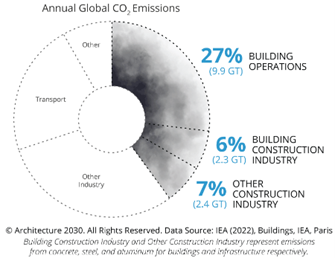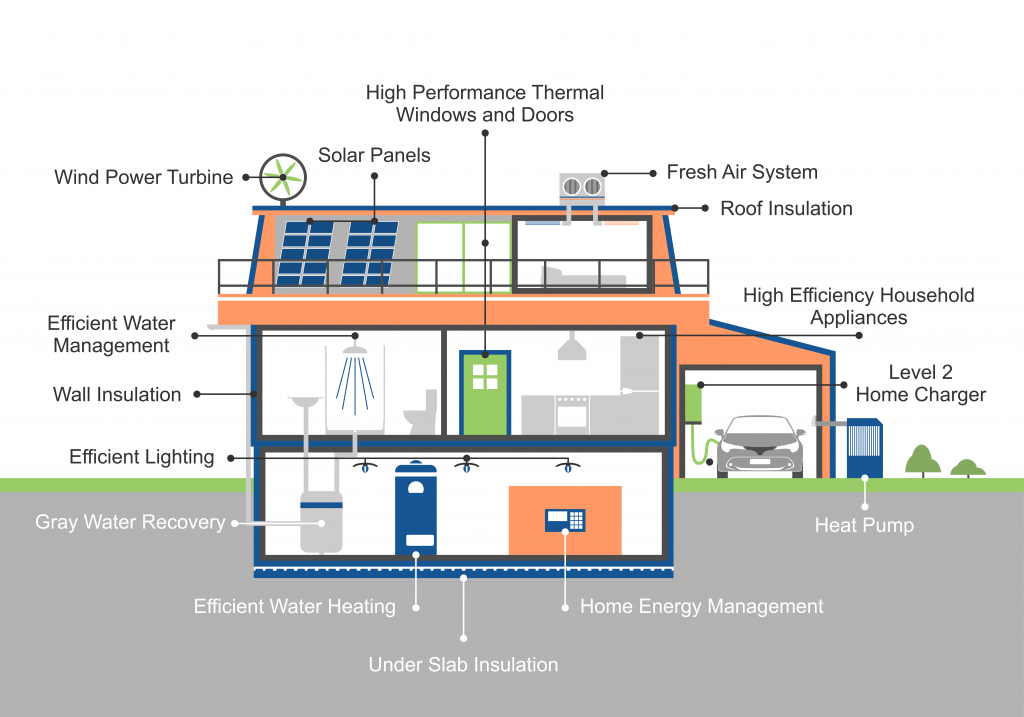Net Zero Buildings – An Overview

Buildings account for nearly forty per cent of global greenhouse gas (GHG) emissions, according to a study published in Architecture 2030.

Out of this total GHG emission, 27 per cent can be attributed to the occupancy and operation of the building, including energy requirements for heating and ventilation and running various appliances. The balance 13 per cent contribution is in the form of embodied carbon in the materials used for construction. Estimates show that at least 2/3rd of the existing buildings will last in 2040 and continue to have a large carbon footprint. Interventions are required in this sector to upgrade efficient energy use and substitute fossil fuels with renewables. This has led to the development of the concept of net zero buildings.
Net zero buildings are structures that produce as much energy as they consume over a year. These buildings can generate energy through renewable sources, such as solar panels or wind turbines, and use energy-efficient systems and appliances to minimise energy consumption. Ref Figure 1, where schematics of net zero building system are conceptualised.

Figure 1: Schematics of Net-Zero Building System Architecture
The concept of net zero buildings is becoming increasingly popular as the world works to combat climate change and reduce its dependence on fossil fuels. These buildings not only help reduce greenhouse gas emissions but also offer a few other benefits, such as lower energy costs for the occupants and improved indoor air quality.
Key Enablers
One of the key components of a net zero building is its use of renewable energy sources. Solar panels, wind turbines, and geothermal systems are all commonly used to generate electricity, while solar thermal systems can provide hot water. In addition, many net zero buildings also incorporate energy storage systems, such as batteries, to store the energy generated during the day for use at night or during periods of peak demand.
Another important aspect of net zero buildings is energy efficiency. These buildings are typically designed and constructed to minimise energy loss, with high-efficiency windows, insulation, and air-sealing features. Energy-efficient appliances, lighting, and HVAC systems are also used to reduce energy consumption further. Ref Figure 2 for key enablers.
The key enablers of Net-Zero Buildings are as follows –
- Design to reduce material use
- Pre-cast/3D Printing/Prefab
- Modularization & standardization
- Digitally enabled and SMART
- Alternate material
- Alternate energy (Solar, wind, bio)
- Equipment (HVAC, water, Pump)
- Reuse (waste, water, heat)
- Low carbon transport (EV, H2)

Figure 2: Zero Carbon Buildings
Net zero buildings also place a strong emphasis on indoor air quality. These buildings typically have good ventilation systems and high-efficiency filters to remove pollutants and improve overall air quality.
Net-Zero Certification [1]
In 2018, the Indian Green Building Council (IGBC) introduced the IGBC Net Zero Energy Buildings Rating System. This rating system is a tool that allows designers to apply energy efficiency concepts and incorporate appropriate renewable sources into their designs to achieve Net Zero Energy Status. In the case of an existing building, the tool enables the implementation of energy-efficient measures to reduce energy consumption while meeting the remaining energy needs with renewable energy sources.
The rating system evaluates buildings on a performance-based approach. The rating system is evolved to be comprehensive and, at the same time, user-friendly. The programme is fundamentally designed to reduce the energy needs of a building and national priorities.
The threshold criteria for certification levels are as under:
| Certification Level | Credit points | Recognition |
| Net Zero Energy | <80 | Best Practices |
| Net Zero Energy Platinum | 80 and above | Outstanding Performance |
Net Zero Energy Buildings that achieve one of the rating levels will be recognised with a formal letter of certification and a mountable plaque from the IGBC. Net Zero Energy certification can be obtained at the design or operational stages. A building that achieves Net Zero Energy Certification at the Design State level must demonstrate Net Zero Energy Performance after one year of operation.
Construction
Constructing a net zero building typically involves several different steps, including:
Site Selection: The first step in constructing a net zero building is selecting an appropriate site. This typically means choosing a location well-suited for renewable energy generation, such as a site with good solar exposure or proximity to a wind resource.
Building Design: The design of a net zero building should focus on energy efficiency, with features such as high-efficiency windows, insulation, and air-sealing incorporated into the building envelope. The design should incorporate renewable energy systems, such as solar panels or wind turbines, into the building’s architecture.
Building orientation plays an important role in optimising HVAC loads. Moreover, sunshades/overhangs/chajjas are provided to minimise the impact of direct sun rays. Providing insulation, glazing, double-skin facade, etc., are a few technologies to design the site-specific building indoors and envelope.
In a concrete building, it is recommended to use factory-made blended cement manufactured from low-carbon alternate raw materials and cementitious materials as a clinker substitute.
Feasibility of generating maximum captive power demand using rooftop solar system, and such a system can be connected to the grid in case of excess power generated.
Energy Modelling: Before construction begins, energy modelling should be used to determine the energy performance of the building and to identify areas where energy efficiency can be improved. This can also help to optimise the size and placement of renewable energy systems.
Construction: Once the design is complete, construction can commence. The building shall be constructed using energy-efficient materials and techniques such as modular, pre-engineered, pre-fabricated, or precast buildings. The green energy systems/items shall be incorporated into the building design and installed as per the approved design intent. The construction demolition waste, such as broken concrete or bricks etc., can be used suitably.
Commissioning: After construction, the building should be commissioned to ensure that all systems work properly and meet its energy performance targets with an efficient building management system deployed.
Monitoring and Maintenance: Ongoing monitoring and maintenance of the building’s systems, including the renewable energy systems, is essential to ensure that the building continues to perform as expected.
Certification: To be considered a Net Zero Building, it needs to be certified by a recognised certification body such as LEED, Living Building Challenge, Passive House, etc.
Advantages
One of the main benefits of net zero buildings is the cost savings that can be achieved through reduced energy consumption. With rising energy costs, a net zero building can help offset these costs, which can be especially beneficial for commercial buildings and apartment complexes.
Another benefit of net zero buildings is their positive impact on the environment. By producing as much energy as they consume, these buildings help to reduce greenhouse gas emissions, contributing to climate change.
In conclusion, net zero buildings offer many benefits, from cost savings to environmental protection. As the world works to combat climate change and reduce its dependence on fossil fuels, we will likely see more and more net zero buildings being constructed in the future.
Disadvantages
Net zero buildings are designed to produce as much energy as they consume, making them highly energy-efficient and reducing their environmental impact. However, there are several disadvantages to consider when constructing net zero buildings:
Cost: One of the main disadvantages of net zero buildings is their cost. The materials, equipment, and technology required to make a building net zero can be expensive, and this cost is often passed on to the building’s occupants or owners.
Complexity: Net zero buildings can be complex to design, construct, and maintain, requiring specialised knowledge and expertise. This can make it difficult for some builders to construct a net zero building and may require specialised contractors and consultants.
Maintenance: A net zero building requires regular monitoring and maintenance to ensure that its systems work properly and meet its energy performance targets. This can be time-consuming and costly and may require specialised training for the building’s maintenance staff.
Weather Dependence: The energy production of a net zero building is weather dependent; for example, a building with a solar panel system, will produce less energy during a cloudy day; therefore, backup systems or additional energy storage solutions are needed to ensure that the building can meet its energy needs consistently.
Limited Availability of Renewable Energy Systems: In some areas, renewable energy systems such as solar panels or wind turbines may need to be more readily available or too expensive to install. This can make it difficult to achieve net zero status in certain locations.
Resistance to Change: Some building owners and occupants may resist the changes required to make a building net zero, such as installing new technology or changing their energy usage habits.
Certification: Certification of a Net zero building can be a long and costly process and requires a lot of documentation and paperwork. The renewal of certification is done once in two years. This can be a deterrent for some building owners and developers.
Limited Applicability: Net zero buildings may only be suitable for some types, such as large commercial or industrial buildings, with very different energy needs and usage patterns. But in the future, all the new and existing buildings, either residential, commercial, or industrial, may have to comply with the efforts towards the Net-Zero target by 2070.
Despite these disadvantages, many experts believe that the benefits of net zero buildings, including reduced environmental impact and long-term cost savings, make them a worthwhile investment. With the advancements in technology and the increasing awareness of the need to reduce carbon footprint, the cost and complexity of net zero buildings will likely decrease over time, making them more accessible to a wider range of builders and building owners.
Conclusion
Net Zero building is a future vision to achieve sustainable living and working spaces. It’s a combination of energy-efficient building design and renewable energy production. It’s a complex and challenging task to achieve, but it’s a necessary step to move towards a more sustainable future.
The future of net zero buildings in India is likely to see significant growth (The Real Estate Industry in India is expected to reach $1 Tn by 2030 and contribute 13% to India’s GDP) [2] as the country looks to reduce its carbon footprint and meet its climate goals. The Indian government has set a target of constructing 40 GW of renewable energy-powered buildings by 2030, which is expected to drive the development of net zero buildings in the country. Additionally, private companies and organisations are also increasingly committing to building sustainable, energy-efficient buildings. However, many challenges still need to be addressed to achieve this goal, such as lack of awareness about net-zero buildings, lack of proper regulations, lack of trained professionals in the field and lack of enough funding.
It’s important to note that the process of constructing a net zero building can be complex and may require the expertise of a variety of professionals, including architects, engineers, and energy analysts. Additionally, the costs of constructing a net zero building can be higher than those of a conventional building, but the long-term cost savings and environmental benefits make it a worthy investment.
[1] Construction Industry in India | Construction Sector Investments (investindia.gov.in)
[2] https://igbc.in/igbc/redirectHtml.htm?redVal=showNetZeroEnergyBuildingsNosignin





